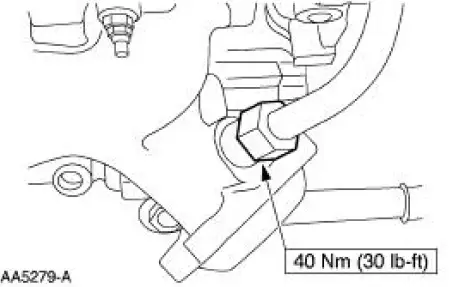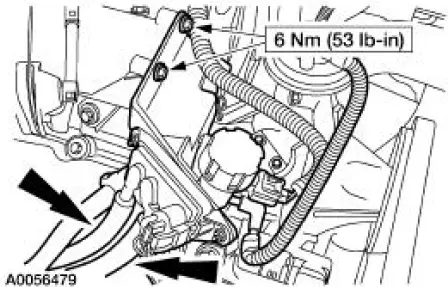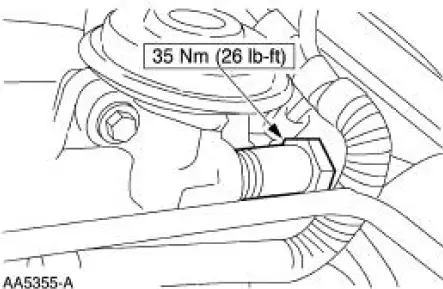Ford Mustang (1999-2004) Service Manual: Exhaust Manifold to Exhaust Gas Recirculation (EGR) Valve Tube
Removal and Installation
NOTE: 3.8L shown, 4.6L (2V) similar.
1. With the vehicle in NEUTRAL, position it on a hoist.
2. Disconnect the exhaust gas recirculation (EGR) valve tube from the exhaust manifold.

3. Remove the differential feedback exhaust gas recirculation (EGR) system vacuum hoses and the bracket bolts. Position the bracket assembly aside.

4. Disconnect the EGR tube from the EGR valve.

5. Remove the exhaust manifold-to-EGR valve tube.
6. To install, reverse the removal procedure.
 Exhaust Gas Recirculation (EGR) Valve - Mach I
Exhaust Gas Recirculation (EGR) Valve - Mach I
Removal and Installation
1. Remove the air intake scoop. For additional information, refer to
Section.
2. Remove the exhaust gas recirculation (EGR) valve.
1. Disconnect the EGR tube upper fi ...
 Exhaust Manifold to Exhaust Gas Recirculation (EGR)
Valve Tube - Cobra
Exhaust Manifold to Exhaust Gas Recirculation (EGR)
Valve Tube - Cobra
Removal and Installation
1. Remove the EGR valve. For addditional information, refer to Exhaust
Gas Recirculation (EGR)
Valve-Cobra in this section.
2. With the vehicle in NEUTRAL, position it on ...
Other materials:
Rocker Arms - Inspection
CAUTION: Do not attempt to true surfaces by grinding. Check the
rocker arm pad, side
rails and seat for excessive wear, cracks, nicks or burrs. Check the rocker
arm seat bolt for
stripped or broken threads. Install new components as ncessary or possible ...
Exhaust Manifold RH
Removal and Installation
1. Disconnect the battery negative cable. For additional information,
refer to Section.
2. Remove the air cleaner outlet pipe. For additional information, refer to
Section.
3. Disconnect the differential pressure feedback exha ...
Windshield washers
Note: Do not operate the wipers on a dry windshield. This may scratch
the glass, damage the wiper blades or cause the wiper motor to burn out.
Always use the windshield washer before wiping a dry windshield.
Note: Do not operate the washer when the washer re ...
